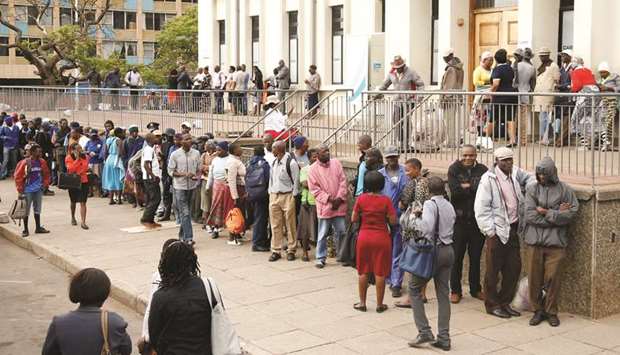Zimbabwe’s central bank yesterday injected new banknotes and coins into the cash-strapped economy to ease chronic shortages but the weekly withdrawal limit per customer was still capped at US$18 — a sum which fetches less than 3kg of beef.
The Zimbabwean dollar is being gradually reintroduced after being rendered worthless by decades of economic mismanagement under former president Robert Mugabe.
A decade ago hyperinflation reached 500bn%, forcing the country to trash its own currency.
Zimbabwe had to rely on US dollars for a decade until June this year when authorities banned the use of the greenback.
New two- and five- Zimbabwean dollar notes were disbursed by the central bank.
One Zimbabwean dollar is currently worth around six US cents.
“Bond” notes — a legal tender pegged to the US dollar — were introduced in 2016 to alleviate chronic cash shortages and ease a transition back to Zimbabwean dollars.
These were then supplemented with electronic dollars in June 2019.
But cash remains hard to come by and most people use mobile digital money and now-banned foreign currencies to pay for goods.
Account holders have to spend hours to withdraw cash.
Bank customers remained sceptical in the capital Harare.
“There is no difference,” Milton Mushangwe, 37, told AFP. “The withdrawal limits remain the same.”
“We are still getting the same small amount of Z$100 or less,” added Richard Govha, another customer.
Zimbabwe’s reserve bank said that only 31mn new Zimbabwean dollars (less than US$2mn) had been disbursed so far, of a planned total of 1bn that is to be drip-fed into the system over the next six months.
But analysts believe that currency shortages are not the source of the economic woes.
“Our challenge is not the currency. Our problems are production and perception,” independent economic analyst Gift Mugano told AFP.
Electricity is only available for around six hours a day, leaving the manufacturing sectors almost redundant.
Officially inflation is around 300%, but prices of goods and services have gone up more than that.
“As long as we have inflation in triple digits and still going up, the new currency will not hold. We are not solving anything when we are going to need a bunch of banknotes to buy a handful of groceries,” said Mugano.
Inflation has eroded salaries so much that doctors and some public sector workers have stopped going to work because they just cannot afford to commute.
Many families live on one meal a day, with the southern African country in the grip of a major downturn that has provoked biting shortages of basics such as fuel and medicine.
Hundreds of people, mostly pensioners, queued for cash outside one bank in central Harare and were issued Z$150 (US$10) of the new 2-dollar bills and coins.
They were told to return tomorrowif they wanted more.
“I managed to withdraw Z$150 but it is not enough to buy anything. The banks should do something about the limit, maybe increase it to Z$1,000,” John Kamuzunga, a 72-year-old pensioner, told Reuters after collecting his cash.
Central bank governor John Mangudya did not respond yesterday to calls for comment.
But he was quoted in the government-owned Herald newspaper saying the Reserve Bank of Zimbabwe had disbursed Z$30mn in new notes to banks.
Tony Hawkins, a professor of business studies at the University of Zimbabwe, had said on Monday the new notes would not solve the country’s economic problems.
“What it means is that we will probably have more cash around to feed the black market for currency,” he said.
Cash is the preferred method of transacting business in an economy where unemployment is above 80% and the majority of citizens earn a living from trading in the informal sector.
After the trauma of hyperinflation, when many were left impoverished after losing savings and pensions, Zimbabweans tend to prefer to keep cash at home because they have little faith in the country’s financial system.

People queue to withdraw money from a bank in Harare yesterday.


